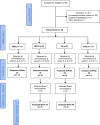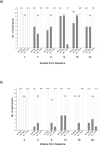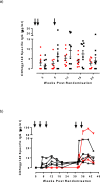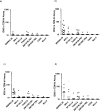Comparative Immunogenicity of HIV-1 gp140 Vaccine Delivered by Parenteral, and Mucosal Routes in Female Volunteers; MUCOVAC2, A Randomized Two Centre Study
- PMID: 27159166
- PMCID: PMC4861263
- DOI: 10.1371/journal.pone.0152038
Comparative Immunogenicity of HIV-1 gp140 Vaccine Delivered by Parenteral, and Mucosal Routes in Female Volunteers; MUCOVAC2, A Randomized Two Centre Study
Abstract
Background: Defining optimal routes for induction of mucosal immunity represents an important research priority for the HIV-1 vaccine field. In particular, it remains unclear whether mucosal routes of immunization can improve mucosal immune responses.
Methods: In this randomized two center phase I clinical trial we evaluated the systemic and mucosal immune response to a candidate HIV-1 Clade C CN54gp140 envelope glycoprotein vaccine administered by intramuscular (IM), intranasal (IN) and intravaginal (IVAG) routes of administration in HIV negative female volunteers. IM immunizations were co-administered with Glucopyranosyl Lipid Adjuvant (GLA), IN immunizations with 0.5% chitosan and IVAG immunizations were administered in an aqueous gel.
Results: Three IM immunizations of CN54 gp140 at either 20 or 100 μg elicited significantly greater systemic and mucosal antibodies than either IN or IVAG immunizations. Following additional intramuscular boosting we observed an anamnestic antibody response in nasally primed subjects. Modest neutralizing responses were detected against closely matched tier 1 clade C virus in the IM groups. Interestingly, the strongest CD4 T-cell responses were detected after IN and not IM immunization.
Conclusions: These data show that parenteral immunization elicits systemic and mucosal antibodies in women. Interestingly IN immunization was an effective prime for IM boost, while IVAG administration had no detectable impact on systemic or mucosal responses despite IM priming.
Clinical trials registration: EudraCT 2010-019103-27 and the UK Clinical Research Network (UKCRN) Number 11679.
Conflict of interest statement
Figures






Similar articles
-
Mucosal and systemic anti-HIV responses in rhesus macaques following combinations of intranasal and parenteral immunizations.AIDS Res Hum Retroviruses. 2004 Nov;20(11):1269-81. doi: 10.1089/aid.2004.20.1269. AIDS Res Hum Retroviruses. 2004. PMID: 15588349
-
Boosting with Subtype C CN54rgp140 Protein Adjuvanted with Glucopyranosyl Lipid Adjuvant after Priming with HIV-DNA and HIV-MVA Is Safe and Enhances Immune Responses: A Phase I Trial.PLoS One. 2016 May 18;11(5):e0155702. doi: 10.1371/journal.pone.0155702. eCollection 2016. PLoS One. 2016. PMID: 27192151 Free PMC article. Clinical Trial.
-
Antibody responses after intravaginal immunisation with trimeric HIV-1 CN54 clade C gp140 in Carbopol gel are augmented by systemic priming or boosting with an adjuvanted formulation.Vaccine. 2011 Feb 4;29(7):1421-30. doi: 10.1016/j.vaccine.2010.12.034. Epub 2010 Dec 25. Vaccine. 2011. PMID: 21187177 Free PMC article.
-
Inclusion of a CRF01_AE HIV envelope protein boost with a DNA/MVA prime-boost vaccine: Impact on humoral and cellular immunogenicity and viral load reduction after SHIV-E challenge.Vaccine. 2012 Feb 27;30(10):1830-40. doi: 10.1016/j.vaccine.2011.12.131. Epub 2012 Jan 9. Vaccine. 2012. PMID: 22234262 Free PMC article.
-
Induction of HIV-1-specific mucosal immune responses following intramuscular recombinant adenovirus serotype 26 HIV-1 vaccination of humans.J Infect Dis. 2015 Feb 15;211(4):518-28. doi: 10.1093/infdis/jiu485. Epub 2014 Aug 26. J Infect Dis. 2015. PMID: 25165165 Free PMC article. Clinical Trial.
Cited by
-
Combined Skin and Muscle DNA Priming Provides Enhanced Humoral Responses to a Human Immunodeficency Virus Type 1 Clade C Envelope Vaccine.Hum Gene Ther. 2018 Sep;29(9):1011-1028. doi: 10.1089/hum.2018.075. Hum Gene Ther. 2018. PMID: 30027768 Free PMC article. Clinical Trial.
-
Systematic comparison of HIV-1 Envelope-specific IgG responses induced by different vaccination regimens: Can we steer IgG recognition towards regions of viral vulnerability?Front Immunol. 2023 Jan 9;13:1075606. doi: 10.3389/fimmu.2022.1075606. eCollection 2022. Front Immunol. 2023. PMID: 36741409 Free PMC article.
-
Immunoglobulin G1 Allotype Influences Antibody Subclass Distribution in Response to HIV gp140 Vaccination.Front Immunol. 2017 Dec 20;8:1883. doi: 10.3389/fimmu.2017.01883. eCollection 2017. Front Immunol. 2017. PMID: 29326728 Free PMC article.
-
Experimental medicine study with stabilised native-like HIV-1 Env immunogens drives long-term antibody responses, but lacks neutralising breadth.EBioMedicine. 2025 Feb;112:105544. doi: 10.1016/j.ebiom.2024.105544. Epub 2025 Jan 2. EBioMedicine. 2025. PMID: 39753033 Free PMC article. Clinical Trial.
-
Molecular Signatures of a TLR4 Agonist-Adjuvanted HIV-1 Vaccine Candidate in Humans.Front Immunol. 2018 Feb 26;9:301. doi: 10.3389/fimmu.2018.00301. eCollection 2018. Front Immunol. 2018. PMID: 29535712 Free PMC article.
References
-
- Veazey RS, Shattock RJ, Pope M, Kirijan JC, Jones J, Hu Q, et al. Prevention of virus transmission to macaque monkeys by a vaginally applied monoclonal antibody to HIV-1 gp120. Nat Med. 2003;9:343–46. - PubMed
-
- Mascola JR, Stiegler G, VanCott TC, Katinger H, Carpenter CB, Hanson CE, Beary H, et al. Protection of macaques against vaginal transmission of a pathogenic HIV-1/SIV chimeric virus by passive infusion of neutralizing antibodies. Nat Med. 2000;6:207–10. - PubMed
Publication types
MeSH terms
Substances
Grants and funding
LinkOut - more resources
Full Text Sources
Other Literature Sources
Research Materials

